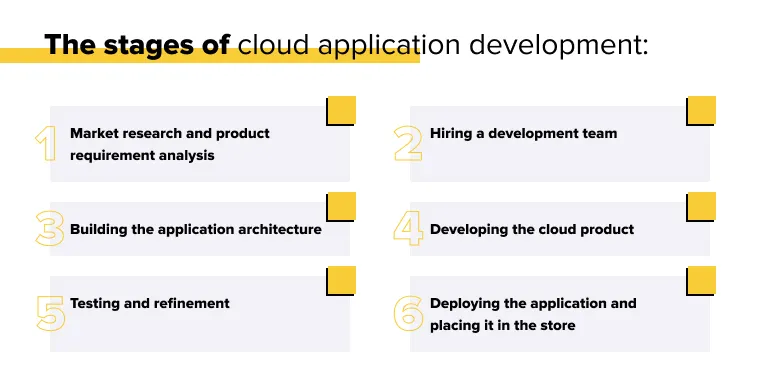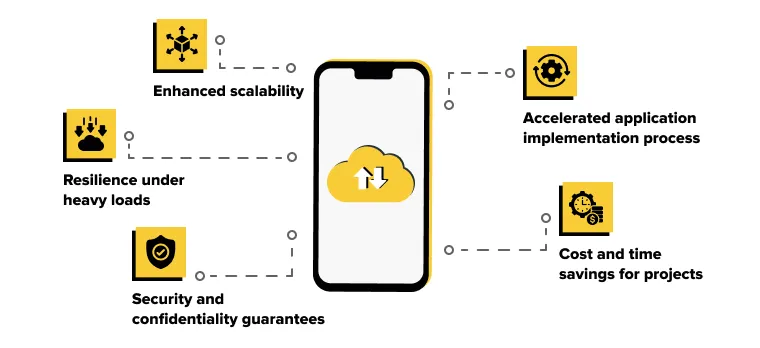According to Grand View Research, the global cloud computing market was valued at $483.98 billion in 2022. Experts also predict that the compound annual growth rate of the market from 2023 to 2030 will be 14.1%. Statistical data from Lambert Consulting also shows that in 2023, 94% of companies use at least one cloud service in their operations.
The increasing popularity of cloud application development can be attributed to various reasons. The team at Lampa has delved into this topic extensively and is ready to share all the possibilities and benefits of using cloud technologies for crafting digital products.
What Are Cloud Applications and How Are They Developed?
Cloud apps are those that operate within a cloud environment. They combine the advantages of web and mobile programs while avoiding their common issues.
For instance, a cloud app can be used offline. Web solutions lack this feature, and mobile apps that work without an internet connection often struggle with user response speed. Cloud-based programs don't have these problems, prompting companies to increasingly opt for such solutions.

Cloud-native application development involves creating new applications using cloud computing technologies, ensuring flexibility and scalability. Furthermore, these digital products attain higher levels of security and can include data backup features on cloud servers.
Cloud applications development is built on 4 fundamental principles:
Microservices architecture: Essential for breaking development into components, ensuring optimal performance for each service.
Continuous Integration (CI) and Continuous Delivery (CD): Enables regular testing and code updates without wasting time on reworking. This guarantees a swift programming process and uninterrupted app performance.
DevOps practices: Necessary for collaboration between development and operations teams, maximizing flexibility and constant project updates.
Containerization: Aids in reducing costs and enhancing development efficiency by grouping and packaging app components into containers.
Application development is a process that requires thorough preliminary research. The preparatory approach for working on cloud apps mirrors that of mobile and web solutions.
Leveraging Cloud Infrastructure
Cloud infrastructure refers to the essential computing resources needed for development: servers, storage, visualization tools, and more. A cloud service provider manages all of this. They also grant access to additional capabilities such as backup replication and recovery, data encryption for heightened security, use of APIs and admin panels, clustering, and more.
Among the most popular cloud platforms are:
Amazon Web Services (AWS): a cloud computing platform offering comprehensive toolsets and solutions for both enterprises and development companies.
Microsoft Azure: Microsoft's public cloud platform for cloud-based application development and data storage.
Google Cloud: a suite of cloud resources providing developers with the same infrastructure Google uses to create various applications.
Infrastructure as a Service (IaaS) lets you use just the necessary amount of servers, tools, and services. This avoids less efficient approaches and models for implementing a cloud solution, thus reducing costs. Additionally, providers offer reliable cloud storage for your data, decreasing the risk of leakage or loss.
Utilizing Platform as a Service (PaaS)
The PaaS cloud model is designed to provide various development tools that simplify the work process. They also furnish you with middleware, operating systems, database management services, and more. Platform as a Service allows you to rent all necessary software and hardware resources for app creation.
Such an approach greatly helps businesses save on equipment, maintenance, and support costs for an internal cloud architecture to develop digital products. Next, we'll delve into the advantages of developing cloud applications.
Benefits of using cloud-based solutions:

Building Scalable and Resilient Applications
Developing applications that run on cloud servers resolves scalability and resilience issues. Thanks to cloud hosting, programs deployed on it run on multiple servers simultaneously. This ensures flexibility and an easy expansion process for your app.
As your digital product grows, it will require more power to handle increasing demands. The development company can provide cloud resources equipped for rapid scalability.
This lets you promptly introduce necessary updates and improvements, enhancing user experience. Moreover, implementing a scalable cloud architecture (auto-scaling and load balancing) boosts application resilience, even with many concurrent users.
Security and Data Privacy in the Cloud
Typically, the development process involves sensitive corporate information, and the final product might contain customers' data. Reliable cloud app developers utilize data encryption standards, SSL protocols, reverse proxy servers, and other methods to ensure security during cloud-based application development.
To gain appropriate data access, you can choose from four types of clouds:
Public cloud provides online data access from any device and offers high computational power.
Private cloud functions as a private web system accessible only to representatives of a single company.
Hybrid cloud combines characteristics of public and private clouds, enabling developers to distribute data between on-device services and third-party services for optimized cloud deployment.
Community cloud grants access to two or more organizations needing to exchange data for their respective operations.
Data in the cloud is also safeguarded against loss due to critical failures or cyberattacks. By using cloud app development services, you can back up and recover all necessary information in case of emergencies.
DevOps and Continuous Integration/Continuous Deployment (CI/CD)
As a key principle in working on a cloud solution, DevOps accelerates product release and ensures reliability. This practice facilitates automated testing and deployment of a cloud-native application, reducing the need for manual intervention.
One of DevOps' tactics – CI/CD – employs automated tools for flexible and dependable operations. A pipeline process is established in cloud apps development, with code writing, testing, and refinement cycling through. This significantly speeds up solution creation, error identification and correction, and market release.
We employ proven cloud frameworks, technologies, and tools at Lampa to support the DevOps approach. We consistently test new technologies and collaborate with popular clouds to offer the best solutions for bringing your ideas to life.
Performance Optimization and Monitoring
To optimize performance in a cloud environment, automatic scaling tools are employed. They balance the server load as the number of users increases.
Unlike when hosted on a local server, a cloud-native application allows instant scalability. This means customers receive rapid responses to their requests, enhancing user experience and boosting loyalty to your product.
Cloud-based application development requires continuous performance monitoring to ensure smooth and correct operations. The cloud storage location isn't tied to your company's or service provider's physical location, and cloud networks can span the globe. This means that if one system fails, your app can continue working at its regular pace.
Cost Optimization and Management
Cloud app development services are a cost-effective option for companies with limited budgets. A development company provides only the tools, technologies, and resources you need for high-quality work. Plus, you don't need to purchase the equipment yourself, as you receive a ready-to-use infrastructure for your cloud app.
The provider also handles developer team management and workspace provisioning. This approach accelerates the development start and aids in promptly resolving emerging issues and making important product changes.
Many provider companies, in addition to cloud app development services, offer assistance with cloud migration. This service allows you to modernize your business and safely transition your software or mobile app to virtual servers swiftly.
Hybrid and Multi-Cloud Environments
Hybrid and multi-cloud environments are two distinct approaches to organizing cloud infrastructure. They share some characteristics but also have significant differences. Let's explore the features inherent in both approaches:
Using multiple cloud providers or platforms simultaneously.
Quick adaptation of apps to growing performance and capacity needs.
Capability to develop various types of cloud applications.
Ensuring high-level data protection through task distribution across different clouds.
The key differences are as follows:
A hybrid cloud typically combines your private infrastructure with public clouds, like AWS or Microsoft Azure.
A multi-cloud environment involves using several public platforms without necessarily incorporating private cloud in development.
A hybrid cloud is primarily used by enterprises that need to maintain the confidentiality of certain data and manage corporate apps themselves. Multi-cloud setups are more suitable for companies aiming to make their product more flexible and efficient. However, choosing a cloud environment depends on your business direction, corporate goals, needs, app type, and other factors.
Conclusion
The spread and active use of cloud technologies come with a range of advantages:
Time and resource savings.
Simple scalability process.
Enhanced data security.
High level of resilience.
Preservation of confidentiality.
Accelerated development and release.
All these benefits of using cloud-based solutions can help elevate your business's competitiveness in the market. Apps that operate in the cloud don't rely on the presence of a browser on a device and can perform essential functions without an internet connection. This significantly boosts your product's value in users' eyes, directly impacting the success and profitability of your company.
Do you have an idea for creating a cloud-native application? Share your thoughts with Lampa Software specialists to get the most optimal and secure path for its realization.